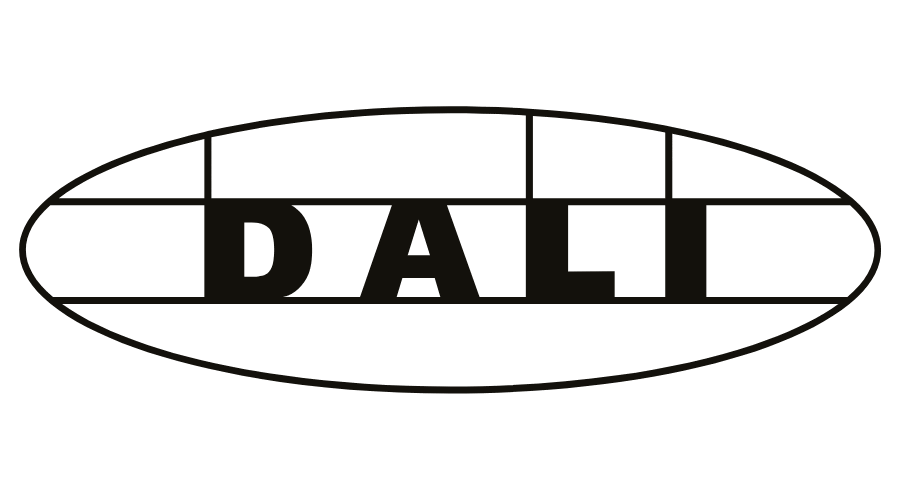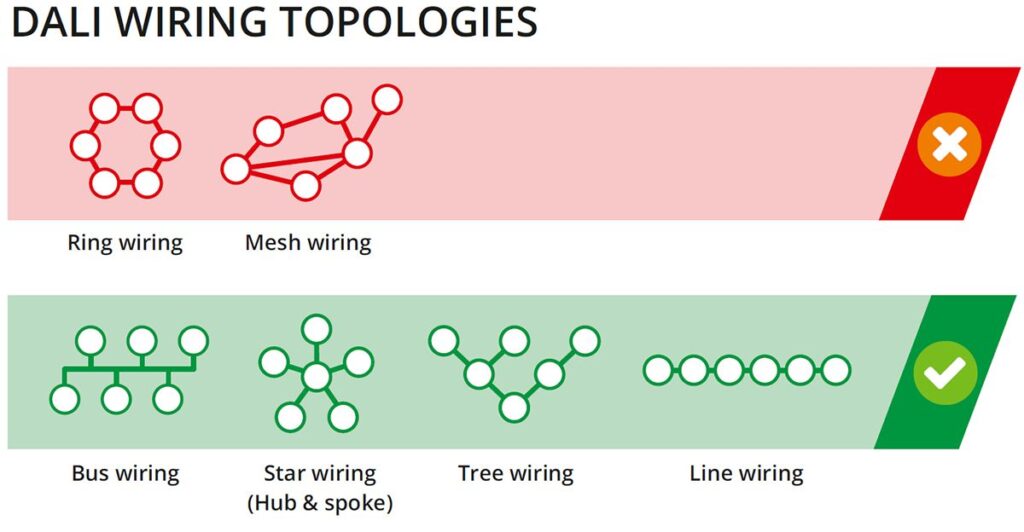Digital Addressable Lighting Interface is what DALI refers to. A lighting system’s components can be controlled and can communicate with one another using this two-way protocol. DALI is an “open protocol”, meaning it is a common platform that can be adopted by all lighting equipment manufacturers. Devices can be grouped and controlled together with DALI because each device is given a unique, individually controllable DALI address.
Please read this article to learn more about DALI.
What Is DALI?
Put simply, DALI is a two-way communication system that brings digital technology to lighting. The commands that LED drivers and ballasts must recognize are set forth by DALI, an international communication standard. The system allows individual LED drivers and ballasts to “talk” to the user, and allows the user to “talk” back via DALI controllers, computers with the necessary software installed, or building management systems.
Similar to computer networks, DALI broadcasts messages, which are received by the ballasts via addresses. It is picked up and delivered to the ballast at that address as directed. All lights in Room 10 turn off, it would be a straightforward message. All the lights in Room 10 know who they are after you send that message. When they receive that message, they inform the recipient that they must turn off. And that is what takes place.
DALI shares characteristics with a 0-10V system, such as low-voltage wiring and daylight harvesting capabilities.
In a 0-10V system, communication is one-way; the control system instructs the LED driver or ballast what to do, and it modifies in response to the voltage on the control circuit. The LED driver or ballast can converse with each other through DALI, which offers a two-way communication channel.
In IEC60929, DALI was first introduced in the late 1990s. It has undergone significant change since then. DALI-2, which is the current (2020) version, is described in IEC62386.
Key Features Of DALI

- Any manufacturer can use it because it is an open protocol.
- DALI-2 certification requirements ensure interoperability between manufacturers.
- It is simple to install. There is no need for shielding when power and control lines are laid together.
- A star (hub and spoke), a tree, a line, or any combination of these can be the wiring topology.
- Since communication is digital rather than analog, multiple devices can receive the exact same dimming values, resulting in very stable and accurate dimming performance.
- Since every device in the system has a distinct address, there are a ton of options for flexible control.
Benefits Of Using A DALI System
Using a DALI system has many advantages over other lighting systems, including greater flexibility and programmability, superior system monitoring, and easier installation. Here is a quick overview of the main benefits:
- Lighting can be reconfigured without needing to rewire: Each dimmable LED bulb’s operation can be changed without requiring circuitry to be rewired. You could program the lighting to work as two separate groups rather than one, for instance, if a room was divided into an office and a meeting space.
- Lights can be programmed to suit your needs: Your lighting schedule can be modified to meet your needs or the specifications of the room. If the room receives a lot of natural light, for example, you might want to set the lighting levels to low; alternatively, if you only want to use a certain amount of electricity, you can set a limit on the lighting level.
- Different settings are possible within one system: Two or more light settings can be controlled by the same system, which is particularly helpful for big commercial buildings. For instance, by programming two distinct profiles, you can accommodate the lighting requirements of various businesses even if they are located on the same floor of a building.
- Installation is simpler than other systems: DALI’s five wire system and lack of additional circuit controls make it much easier to install than other systems while still providing a high level of customizability. Additionally, it means that any installation or maintenance work can be finished quickly and with little downtime.
- Easy custom settings can be accessed at the touch of a button: A DALI system can provide simplified presets for quick and effective lighting program switching, depending on the needs of the space. Presets for each can be made and switched between, for instance, if a hall were rented out as a concert venue by night and a meeting space by day.
- Quick and accurate monitoring is possible: The most precise and current information can be quickly requested because there is a two-way communication system between the control and each luminaire. This implies that you can check on the energy usage of each individual light as well as monitor whether all lights are operational and other system problems.
How Does A DALI Lighting System Work?
The central component of DALI is a bus, which is made up of two wires that connect an application controller to input devices (like sensors) with digital control signals. The application controller uses the set of instructions it was given to create outgoing signals for equipment like LED drivers.
- Power supply unit (PSU) for buses. This element must always be present. It keeps the bus voltage at the necessary level.
- Led Fittings . Every light fixture in a DALI installation needs a DALI driver. Direct DALI commands from the DALI bus can be accepted by a DALI driver, which can then react as necessary. The drivers may be DALI or DALI-2 devices, but if they are not DALI-2, they will not have any of the new features added with this most recent version.
- Sensors, switches, and other input devices Using 24-bit data frames, these exchange information with the application controller. With the control devices, they don’t have direct communication.
- Instances.A sensor, for example, is frequently made up of several different devices. For instance, sensors frequently have a movement detector (PIR), a light-level detector, and an infrared receiver. These are referred to as instances, and each device has three instances. DALI-2 allows each instance to be a member of a different control group and to be addressed to control various lighting groups.
- Application controllers are control devices. The application controller is the “brains” of the system. It sends control gear 16-bit commands after receiving 24-bit messages from sensors and other devices. The application controller also controls the DALI bus’s data flow, monitoring it for collisions and reissuing commands as necessary.
How Are DALI Lighting Systems Wired?
The luminaires in DALI lighting systems function as slave units in a master-slave architecture, receiving information from the controller. The slave units carry out commands from the control or respond to information requests, such as determining whether the unit is operational.

A bus or a two-wire control wire can be used to transmit the digital signals. While both negatively and positively polarized wires are possible, control gears are typically devoid of polarity to guarantee an unbiased connection. There is no requirement for shielded cables, and a DALI system can be wired using a typical five-wire cable.
Since a DALI system does not require wiring groups, all of the wires are connected to the bus in parallel, which is one of the major differences between it and other lighting systems. Additionally, since this information is conveyed in the commands sent from the control, mechanical relays are not required to operate lights. DALI lighting systems are as a result very flexible and have very straightforward wiring systems.
The system and the controller’s software can be configured once the wiring is finished. Numerous scenarios and lighting programs can be created, and because the system is adaptable, they can be used without modifying the wiring. With the ability to change regulation ranges and fade rates, each light’s settings are highly customizable.
Where To Use DALI Lighting Systems?
DALI system is used to control lighting in large commercial and residential areas where lighting automation is required. The ability to control both solitary and grouped lighting systems is made possible by DALI. A central control unit manages everything and provides easy access to all of the building’s luminaires.
This lighting system is popular in many commercial settings. With this sophisticated control, different lighting systems can be set up on the same floor according to the needs of various offices. Commercial offices, production facilities, and business centers all require special lighting.
The uniqueness of this situation can be catered to and controlled holistically by an effective control system like DALI. A bird’s eye view of the building’s lighting system is provided by its clever two-way communication.
Nowadays, the excellent controllability of the DALI is also of great interest to homeowners. The culture of working from home is popular right now, so anyone who wants to convert a room, such as a bedroom, into a home office can do so without any additional wiring or hassle. You only need to choose from the available configurations for the particular luminaire, and you’re ready to go.
The existing lighting configuration can be upgraded with a DALI system. However, experience has shown that a brand-new installation is necessary for it to function at its best. By doing so, you can avoid the wiring and control circuits from the previous system. The user now has a cleaner, more straightforward, and effective wiring setup.
Is Every DALI Product Compatible With Every Other Product?
Because the specification was so constrained, there were some compatibility issues with the first iteration of DALI. There was no collision detection and only a very small number of commands were available because each DALI data frame only had 16 bits (8 bits for the address and 8 bits for the command). This led to some incompatibilities as various manufacturers attempted to increase its capabilities by adding their own features.
This was surpassed with the introduction of DALI-2.
- DALI-2 has many features not present in the original version and is much more comprehensive in its scope. As a result, the modifications that various manufacturers made to DALI are no longer necessary. For a more detailed description of the DALI-2 architecture, please go to “How does DALI work”, below.
- The Digital Illumination Interface Alliance, the owner of the DALI-2 logo, has placed stringent restrictions on its use. The most important of these is that no product may bear the DALI-2 logo unless it has gone through a separate certification process to ensure that it complies fully with IEC62386.
Subject to some limitations, DALI-2 permits the use of both DALI-2 and DALI components in a single installation. In real life, this entails that DALI LED drivers—the main example—can be utilized in a DALI-2 installation.
Final Thoughts
In summary, DALI presents a significant opportunity to improve a building’s lighting control, flexibility in operation, ease of installation, interoperability, reduction of light maintenance costs, and realizing your wireless lighting control dream.
There is a huge selection of DALI-enabled lighting control products available from all the top manufacturers, and it is now widely acknowledged as the global standard for lighting control.
